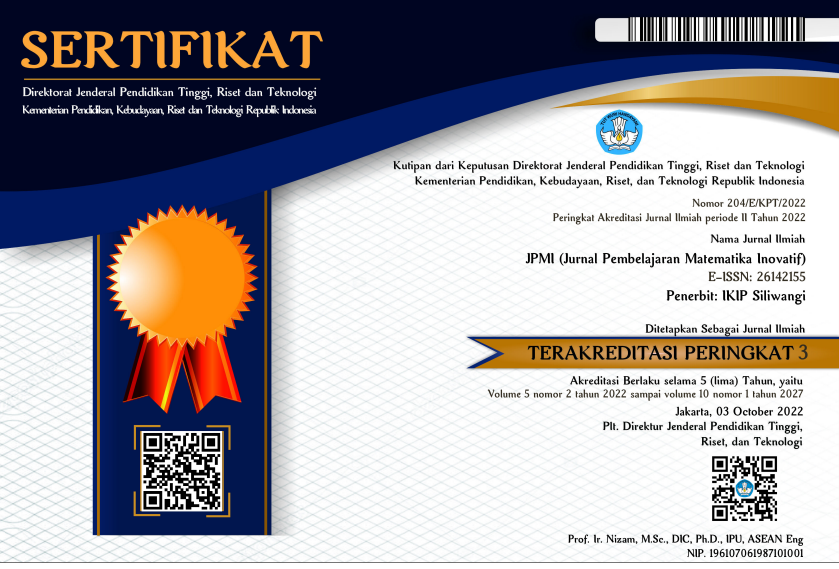ETNOMATEMATIKA DALAM AKTIVITAS PENDISTRIBUSIAN BARANG OLEH PEDAGANG ONLINE
DOI:
https://doi.org/10.22460/jpmi.v6i3.17188Keywords:
Ethnomathematics, Distribution of Goods, Online MerchantsAbstract
References
Armanto, D., Suprayetno, E., Sinaga, K., & Sugiarto, A. (2021). Pelatihan penyusunan instrumen penilaian berbasis hots bagi guru sd it taman cahaya siantar. RESWARA: Jurnal Pengabdian Kepada Masyarakat, 2(2), 379–386. https://doi.org/10.46576/rjpkm.v2i2.1225
D’Ambrosio, U. (1985). Ethnomathematics and its place in the history and pedagogy of mathematics. For the Learning of Mathematics, 5(February 1985), 44-48 (in 'Classics').
Dali, N. S. (2012). Teori sekor pada pengukuran mental : Jakarta: PT Nagarani Citrayasa.
Flora Siagian, R. E. (2015). Pengaruh minat dan kebiasaan belajar siswa terhadap prestasi belajar matematika. Formatif: Jurnal Ilmiah Pendidikan MIPA, 2(2), 122–131. https://doi.org/10.30998/formatif.v2i2.93
Gerdes, P. (1996). “Ethnomathematics and mathematics education. dalam international handbook of mathematical educationâ€. Dordrecht: Kluwer Academic Publiser.
Gunawan, H., & Budi, G. S. (2017). Kajian Emisi kendaraan di persimpangan surabaya tengah dan timur serta potensi pengaruh terhadap kesehatan lingkungan setempat. Jurnal Wilayah Dan Lingkungan, 5(2), 113-124. https://doi.org/10.14710/jwl.5.2.113-124
Mardiana, T., & Purwanto, A. W. (2017). Google form sebagai alternatif pembuatan latihan soal evaluasi. Universty Research Colloquium, 183–188.
Mather, M., & Sarkans, A. (2018). Student perceptions of online and face-to-face learning. International Journal of Curriculum and Instruction, 10(2), 61–76.
Muliadi, M., Fasya, T. K., & Ilham, I. (2020). Wisata ziarah sebagai identitas sosial: studi antropologi budaya di makam sultan malikussaleh kecamatan samudera, kabupaten aceh utara. Aceh Anthropological Journal, 4(1), 58-74. https://doi.org/10.29103/aaj.v4i1.3152
Nur, A. S., Waluya, S. B., Rochmad, R., & Wardono, W. (2020). Contextual learning with Ethnomathematics in enhancing the problem solving based on thinking levels. JRAMathEdu (Journal of Research and Advances in Mathematics Education), 5(3), 331–344. https://doi.org/10.23917/jramathedu.v5i3.11679
Nur, E., Sa, L., & Sigit, D. (2018). Pengembangan instrumen penilaian sikap dan keterampilan psikomotorik pada materi elektrokimia. 2006, 1023–1026.
Nurjamil, D., Muhtadi, D., & Habibah, A. (2021). Studi etnomatematika: mengungkap konsep matematika pada kerajinan anyaman bambu di kecamatan cigalontang kabupaten tasikmalaya. Didactical Mathematics, 3(1), 64–81. https://doi.org/10.31949/dm.v3i1.1444
Prihandoko, C. A. (2006). Pemahaman dan penyajian konsep matematika secara benar dan menarik. Jakarta: Depdiknas.
Rahmaniah, A. (2012). Budaya dan identitas. Dwiputra Pustaka Jaya, Sidoarjo. ISBN 978-602-7761-42-1 UNSPECIFIED : UNSPECIFIED.
Raisa, S., Adlim, A., & Safitri, R. (2018). Respon peserta didik terhadap pengembangan media audio-visual. Jurnal Pendidikan Sains Indonesia, 5(2), 82–86. https://doi.org/10.24815/jpsi.v5i2.9821
Stoddard, H. A., & O’Dell, D. V. (2016). Would Socrates have actually used the “socratic method†for clinical teaching? Journal of General Internal Medicine, 31(9), 1092–1096. https://doi.org/10.1007/s11606-016-3722-2
Sugiyono. (2017). Metode penelitian pendekatan kuantitatif, kualitatif, r&d. Bandung: Alfabeta.
Yanse, F. (2020). Peningkatan hasil belajar matematika melalui pembelajaran matematika realistik pada siswa kelas VI SD Negri kembaran kecamatan candimulyo magelang. Warta Pendidikan, 5(3), 32–36. http://jurnal.warta-pendidikan.com/ojs/index.php/WP/article/view/85/85
Yunika, V., T, A. Y., & Suratman, D. (2020). Kemampuan koneksi matematis siswa dengan pendekata looking back dalam materi aritmatika sosial. Pontianak: Tanjungpura University.

















